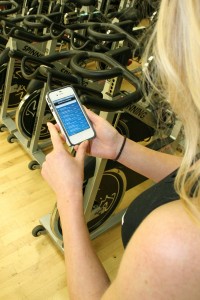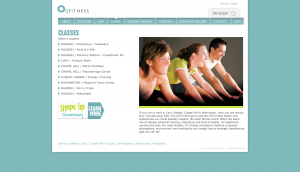
Before the invention of the Internet, clubs were limited to interacting with members in person. As a result, clubs had a short window of opportunity to make a positive impression. Since the commercialization of the Web in the mid 1990s, clubs now have a plethora of opportunities to interact with members both inside and outside of the club, via websites, mobile apps, e-mail and more. To find out what online marketing strategies work best, we interviewed clubs to discover how they take advantage of the World Wide Web to reach out to members virtually.
Your Website & Search Engine Optimization
When researching information about a club, one of the very first actions a potential or current member is most likely to make, is visit your website. However, Mike Rucker, the senior digital strategist for Club One, said the best strategy for clubs doesn’t involve “pushing” members and prospects to visit your landing page. Instead, clubs should invite members by posting informational and practical content.
“‘Push’ is not in the Club One vocabulary, at least regarding marketing,” Rucker explained. “Why would anyone react positively to being ‘pushed,’ unless exercising at the gym? Our strategy is to ‘pull’ members in with engaging content and keeping our interactive offerings fresh and exciting.”
Club One recently enforced the initiative to “pull” members in by re-launching its website to provide for a more user-driven experience. The new site improved upon existing features, such as the availability of the group fitness schedule, and provided easier access to location-specific information. It also improved the website’s search functionality, and made it easier for members to acquire a guest pass. In addition, the website re-launch made possible “Live Chat,” a chat box that enables Club One to interact with members one-on-one, in real-time.
According to Rucker, the re-launch was well worth Club One’s time. “The new website is part of Club One’s commitment to continually improve our touch points,” he explained. “To accomplish this requires a consistent attention to detail and a willingness to capitalize on opportunities to improve. Since the launch of the new website we have seen almost a 100 percent improvement in Web leads compared against the same 30-day period from last year.”

To provide an interactive experience of its own, O2 Fitness “pulls” members to its website by providing them with a member-login portal where they can track their workouts, diet and personal training appointments. However, according to Shanna Kane, the director of marketing for O2 Fitness, its best online marketing strategy involved enhancing their search engine optimization (SEO).
In order to increase the probability its website would show up higher in search engine results, O2 Fitness hired an external company called Unlimited Web Solutions to enhance its SEO. “Now that we have someone working on our SEO daily, we are able to organically show up in most cases, first position on Google, which allows us to always grab the attention of those looking for a fitness center,” explained Kane.
According to Chris Fallon, the director of operations for Unlimited Web Solutions, clubs can improve their search engine results by using key words and tags on their website, such as “classes,” or “trainers,” and other words associated specifically to the club. To find out what key words you should be using, use the “Google Keyword Tool,” at http://adwords.google.com.
In the end, the interactivity of a club’s website could make it or break it — you want to have a website that members want to visit, and one that is easy to use. “To bring it full circle, be consumer-centric,” said Rucker. “Begin and end with your users’ (members and prospects) needs first, and then figure out how your own key performance indicators can coexist with your users’ goals. Take the opposite approach and watch your business goals atrophy as your site visitors find an alternative website that will deliver on the promise of utility.”
Videos & Mobile Apps
With the popularity and ease-of-use of YouTube, videos have become another great tool for clubs to utilize to inform, entertain and interact with members. One of Urban Active’s popular online marketing strategies involves a throwback to VH1 through Urban Active’s Pop Up Video group fitness class, where members learn dance routines choreographed to a popular song, and tape their performance at the end of the class. The video is then uploaded to Urban Active’s website. “It really keeps everyone engaged and having fun,” said KT Remus, the director of marketing and advertising for Urban Active.
Club One uses videos for fun and educational purposes — if you visit Club One’s Pinterest page, you’ll find links to Club One “how to” videos that provide members with tips on topics such as how to execute proper swimming strokes, or how to make a healthy snack. Other videos highlight staff members. “Video is great because it tells a story other mediums cannot,” said Rucker.
The great thing about the evolution of the Web, is that the videos you post can now be shared with members through your mobile app. O2 Fitness launched its mobile app in May of 2012, and according to Kane, the results have been impressive — since the launch, O2 Fitness has had over 2,500 mobile app downloads. “All we did was put a poster up in our clubs and send one e-mail blast out to our members with a QR code for the iPhone app and for the Droid app,” said Kane. “We were amazed with the results. We had high download numbers by our members in such a short period of time.”
According to Remus, the beauty of a mobile app is its ability to share information almost instantly. For example, if a Group X class has been canceled, Urban Active informs members about the cancellation directly through the app. If a member needs driving directions to a location they don’t normally visit, they can find a map on their phone. “They have ready access to any updates right there in their hand,” said Remus. “It’s everything we’d want our best customer service rep to be.”
Blogs & Social Media
“So you say you want to get fit?” — this opening line to one of O2 Fitness’ weekly blogs is one way O2 Fitness has reached out to members on a personal level, via the Web. O2 Fitness posts two to three blogs per week from staff members across different O2 Fitness locations, on topics such as nutrition, fitness and special events going on within the club. “I like to think that the members enjoy seeing blogs written by team members that they know and trust,” said Kane. “It definitely gets the members’ attention, and we have a lot of views when we post a new blog. There is also a lot of content on our blog about ways to improve themselves physically and emotionally. Our belief is to encourage not only being physically active, but also creating an entire healthy lifestyle, and our blog definitely allows us to push that theory further to our members.”
Whatever you publish to your website, whether it be blogs, videos or updates, a proven great way to promote it is through social media. “We cannot have a website be successful without integrating social media,” said Remus. “Clicks on Facebook and Twitter drive people back to our website. Social media is a moving organism — it keeps things flowing,” she explained.
Club One uses social media as one way to interact with members directly. “We make the best of social media by understanding that social media isn’t about us, it is about our members and prospects,” said Rucker. “We use it to answer questions, post interesting information about things we care about, applaud other’s achievements and brag about our own, etc. Our members are our friends, so we treat them as such.”
Social media, blogs, your website and other forms of online marketing are all great ways to interact with members while in and outside the club. However, according to Remus, the whole point of online marketing should be to interact with members in an educational, yet fun way. “Too many people use the Web for informational purposes only,” she said. “Our website is interactive and fun, and we try to use humor whenever possible. Engage people the way they want to be engaged — be available. Interaction doesn’t always have to be so corporate and staunch.”
As the Internet evolves, evolve with it. Continually consider new ways to market to members via the Web. The Internet was invented in the mid-1990s — who knows what web tools will be invented in the current century for your club to utilize.
By Rachel Zabonick








Great Tips. Video sells and can be used on YouTube, Facebook, Twitter as well as your own site and email blasts.
If you need your own branded video created on a budget… check out here: http://www.privatelabelfitness.com/branded-media/